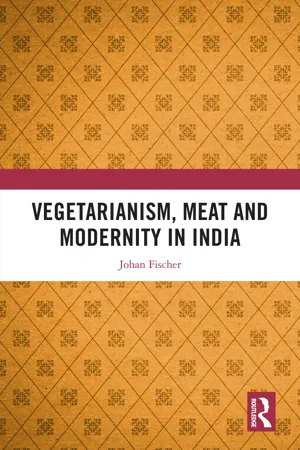
- 240 pages
- English
- ePUB (mobile friendly)
- Available on iOS & Android
Vegetarianism, Meat and Modernity in India
About This Book
Never before in human history have vegetarianism and a plant-based economy been so closely associated with sustainability and the promise of tackling climate change. Nowhere is this phenomenon more visible than in India, which is home to the largest number of vegetarians globally and where vegetarianism is intrinsic to Hinduism. India is often considered a global model for vegetarianism.
However, in this book, which is the outcome of eight months of fieldwork conducted among vegetarian and non-vegetarian producers, traders, regulators and consumers, I show that the reality in India is quite different, with large sections of communities being meat-eaters. In 2011, vegetarian/veg/green and nonvegetarian/ non-veg/brown labels on all packaged foods/drinks were introduced in India. Paradoxically, this grand scheme was implemented at a time when meat and non-vegetarian food production, trade and consumption were booming. The overarching argument of the book is that a systematic study of the complex and changing relationship between vegetarian and non-vegetarian understandings and practices illuminates broader transformations and challenges that relate to markets, the state, religion, politics and identities in India and beyond.
The book's empirical focus is on the changing relationship between vegetarian/ non-vegetarian as understood, practised and contested in middle-class India, while remaining attentive to the vegetarian/non-vegetarian modernities that are at the forefront of global sustainability debates. Through the application of this approach, the book provides a novel theory of human values and markets in a global middle-class perspective.
Frequently asked questions
Information
Table of contents
- Cover
- Endorsements
- Half-Title
- Title
- Copyright
- Dedication
- Contents
- List of Figures
- Acknowledgements
- 1 Veg or Non-Veg?: Transformations in Retail and Consumption and the Rise of Meat Modernity in the Age of ‘the Green’
- 2 Setting the Scene: The Publics and Politics of Green and Brown Labels
- 3 Markets: Manufacturing and Selling Veg and Non-veg Commodities
- 4 Consuming Veg and Non-veg Food
- 5 Good Life Clubs: Of Students, Dalits and Vegans between Meat Modernity and the Second Green Revolution
- 6 Conclusions and Broader Perspectives
- References
- Index